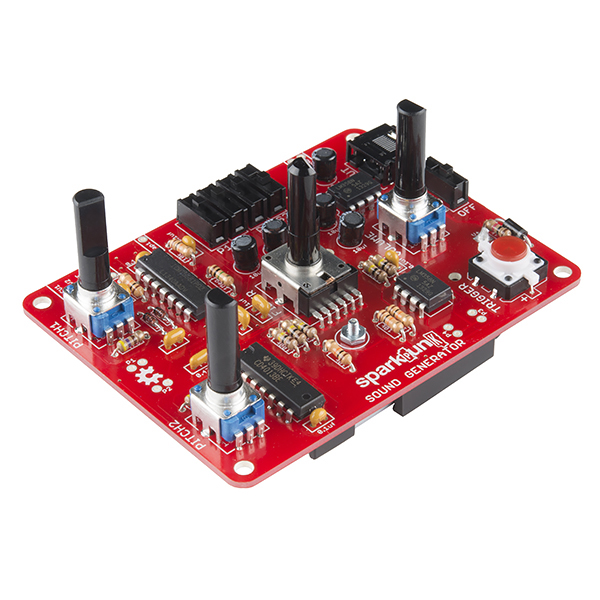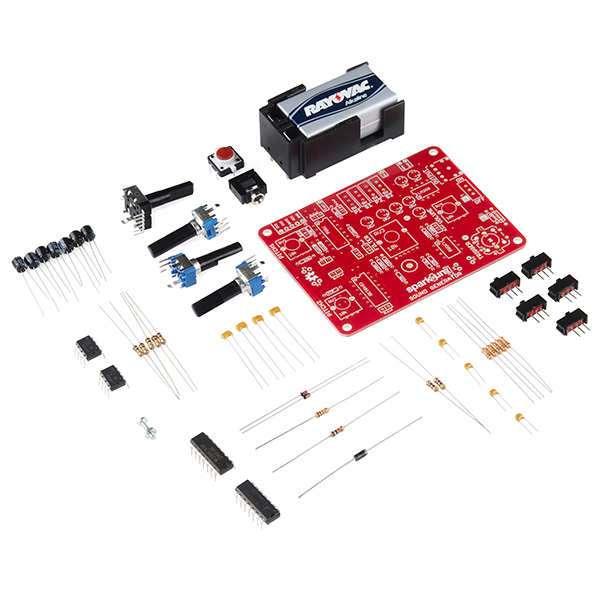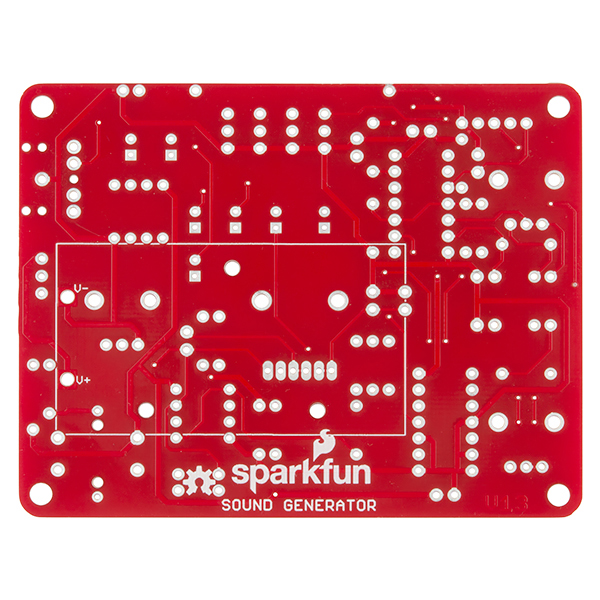SparkFun SparkPunk Sound Kit
The SparkFun SparkPunk Kit is a sound generator made in the spirit of the Atari Punk Console. Rather than simply recreating the Atari Punk, the SparkPunk is a new design that springs from a similar foundation. It starts with a dual 555 timer IC, then adds a second tone source, sub-octaves and a bandpass filter. With all of the knobs and switches, a lot of tonal variations are possible. As a through-hole kit, the SparkPunk can also be easily extended and modified, expanding the palette of tones even further.
The SparkPunk is a very simple synthesizer, using the somewhat conventional arrangement of oscillators that feed a filter. All you need to know to play this sound generator is to press the button, operate the control knobs, listen to the results, and adjust your music to how you want it. The SparkPunk is intended for you to explore and have fun! Some people are drawn to mellow, soothing sounds, while others prefer clangourous tones, and that's fine, to each their own. With all of the controls, you should be able to explore both ends of the spectrum.
In addition, the SparkPunk is quite customizable as well. Any knob with a 0.25" inner diameter can be attached to the tops of each potentiometer, external speaker lines can be soldered into the board for a more permanent sound distrobution option, and photocells can be added to control the kit without actually touching it. There are plenty more optional modifications that can be added and played with.
- 1x SparkPunk PCB
- 1x ICM7556 Integrated Circuit
- 1x CD4013BE Integrated Circuit
- 2x LM358 Integrated Circuit
- 1x 10K Ohm Dual Potentiometer
- 3x 10K Ohm Potentiometer
- 1x Red LED Tactile Button
- 5x Mini Power Switch
- 1x 1N5819 Schottky Diode
- 2x 1N4148 Silicon Diode
- 1x 1M Ohm 1/4W Resistor
- 1x 1K Ohm 1/4W Resistor
- 2x 470 Ohm 1/4W Resistor
- 5x 10k Ohm 1/4W Resistor
- 5x 100k Ohm 1/4W Resistor
- 1x 0.47uF Ceramic Capacitor
- 3x 1uF Ceramic Capacitor
- 5x 0.1uF Ceramic Capacitor
- 7x 10uF 25V Electrolytic Capacitor
- 1x 3.5mm Audio Jack
- 1x 2-56 Nut
- 1x 3/8" 2-56 Phillips Machine Screw
- 1x 9V Alkaline Battery
- 1x 9V Battery Holder
- Operating Voltage: 9V
- PTH Soldering Kit
- Dual Oscillators & Sub-Octaves
- Analog Expansion Port
- Sweepable Band Pass Filter
- Hackable
- Schematic
- Eagle Files
- Hookup Guide
- Datasheet (ICM7556)
- GitHub (Design Files)
- Product Video
SparkFun SparkPunk Sound Kit Product Help and Resources
SparkPunk Sequencer Theory and Applications Guide
August 14, 2014
Examine the inner workings of the SparkPunk Sequencer, then explore some modifications and alternate applications.
Core Skill: Soldering
This skill defines how difficult the soldering is on a particular product. It might be a couple simple solder joints, or require special reflow tools.
Skill Level: Rookie - The number of pins increases, and you will have to determine polarity of components and some of the components might be a bit trickier or close together. You might need solder wick or flux.
See all skill levels
Core Skill: DIY
Whether it's for assembling a kit, hacking an enclosure, or creating your own parts; the DIY skill is all about knowing how to use tools and the techniques associated with them.
Skill Level: Noob - Basic assembly is required. You may need to provide your own basic tools like a screwdriver, hammer or scissors. Power tools or custom parts are not required. Instructions will be included and easy to follow. Sewing may be required, but only with included patterns.
See all skill levels
Core Skill: Electrical Prototyping
If it requires power, you need to know how much, what all the pins do, and how to hook it up. You may need to reference datasheets, schematics, and know the ins and outs of electronics.
Skill Level: Rookie - You may be required to know a bit more about the component, such as orientation, or how to hook it up, in addition to power requirements. You will need to understand polarized components.
See all skill levels
Comments
Looking for answers to technical questions?
We welcome your comments and suggestions below. However, if you are looking for solutions to technical questions please see our Technical Assistance page.
Customer Reviews
4.8 out of 5
Based on 6 ratings:
Great Little Synth
This is a fun little guy who has quite the sound. Spent hours with friend trying our best to recreate popular hits.
The SparkPunk Sound Kit
Sparkfun mails your order post haste! I was so happy b/c my electronics class were making these together and I really messed my first one up, and when I ordered one on my own, these folks made sure it was sent right away, and this is just regular mail, not express, or fast.
Thanks peeps at Sparkfun, I look foreword to checking out other products from you!
Funky Chicken (^_^)
Neat kit for a fair price
I just finished putting this together after receiving it a few weeks ago. I knew some soldering basics but hadn't done it in years, never did it well to begin with. I had this kit together in about 2.5 hours and it worked without any trouble shooting. That's either a testament to me or the kit but I'd bet on the latter. I got this as an intro to building my own modular synthesizers. This was a great place to start and I learned quite a bit along the way. I'll be messing with wiring up some of the extra connections and building an enclosure for it in the near future.
Pretty sweet synth
This was a fun unit to assemble. The price was good, and the result is a very expansive musical instrument with a lot of tonal possibility. I'm glad all the components came in the kit, including a 9V battery, so I didn't have to buy anything else. it was ready to go. My friends loved it. The LED under the trigger button makes it extra cool. Good work! I'm going to get the Step Sequencer next and chain them together.
Everyone loves it!
When friends are over I plug this in to the stereo and they spend hours playing with it. I posted a vid on instagram and now my brother-in-law wants me to build one for him. The breakout modification options are the most fun for me, though. I've been working on some circuits that will allow me to control it with some of my other DIY synth projects. Endless entertainment!
Fun to build, more fun to play
Construction was pretty straight forward except they sent a single 555 timer chip instead of the ICM7556. So check your parts when it arrives. The sound is very good for the price. The filter has a bit of resonance and the sweeps sound very cool. The oscillators are juicy analog and make a nice drone when slightly detuned. I recommend adding some knobs.





While putting mine together yesterday I found out that the box it comes in is magical. I put some standoffs on it and mounted the board to the box and it magically assembled itself. Should really have that in the description, would save people a lot of time putting it together.
http://youtu.be/0qIaUPwvTAQ
Here's my write-up on this kit. Lots of fun. SparkPunk
Planning on wiring the Gram Piano into this thing, any tips or anything I should watch out for?
If you want the simplest connection:
If you turn off all the waveform selector switches, you 'll get the Gram Piano output, as filtered by the SparkPunk filter. If you turn on the waveforms, you get the GP mixed in with the SparkPunk.
If you're a little more adventurous, you could put a potentiometer in between, configured as a voltage divider, to give you an input volume control.
I really enjoyed making this kit. This was my first time soldering IC's, and after this kit I feel much more confident in my soldering skills overall! The way the pitch changes regardless of the position of the switches makes me wonder if I didn't hook it up correctly even though I can definitely tell a difference in the knobs' behavior when P1 or P2 is on. Overall, I'm very satisfied with this purchase, especially for it being a fun kit that left me feeling more skilled after I was done!
I'm glad to hear you enjoyed making your SparkPunk!
If you're concerned that it might not be working correctly, try the following:
Turn on P1, and turn off the other switches, and press the button. The Pitch1 knob should change the pitch, and you shouldn't be able to hear any response to turning Pitch2.
Then reverse that - turn off P1, and turn on P2. Now Pitch2 should change the pitch, and Pitch1 won't have any influence.
Then, turn off all four switches and press the button. You shouldn't hear much of anything - maybe some quiet background hiss.
If you can try that and report back, I can confirm whether it's working, or help you sort out what is going on. You may have inadvertently found your way into circuit-bending territory!
Yah, if you could just, make a video that shows the difference between this and a regular APC, that'd be great.
Clearly it's not just "Here's the APC, now with 10% more squealing!" - your modifications, presumably, have added some sort of tangible change to the sound of the device, right? How about a video where you explain, with audio demonstration, what that difference is? Maybe use an oscilloscope to show how the second tone source affects the interplay of the oscillators? How deep do the sub-octaves get? Can this generate serious bass?
Your little tune is cool, but not particularly useful.
I really do want to see some schematics on that 4-channel DIY mixer.
Gettin' my Mims' on:
Click it for larger version.
Just ordered it(SparkPunk)!!! [EEKS!!!] [JUMP WITH JOY!!!]
Are you guys putting together a mixer kit too, or just the console?
How did Sparkfun get inspiration on this kit?
Sooo... Atari came up with it? And is it like a game console? Still a bit confusing.
No, its been around for a while and it sounded like an Atari (thus the name). Its a noise maker (check out Rob's link below)
Now it just needs a Vocoder.
What is a Vocoder?
It's that robot-voice thingy. Used on tunes such as:
Haha more like most of every Daft Punk record.
"the new Daft Punk record" functions, semantically, as a wildcard.
An Atari what Console? I have never heard about that...
check it
Sooo... Atari came up with it and it is a game console package?
The original dual-555 circuit was designed by Forrest M. Mims. It's in several of his old books, usually called something stoic like "tone generator."
Some lo-fi/noise musicians started building the Mims' circuit, and the name "Atari Punk" was applied, probably because it sounds like the primitive pulse-train sounds that a 2600 made. Games like Combat and Night Driver.
It has nothing to do with Atari Co or their products, and isn't a game in itself.
The SparkPunk is pretty different from the Mims' APC design. The biggest similarity is that it's something small that takes a 9V battery and makes electronic sounds.
Ahhh... I get it now.
I actually built a similar sort of sequencer back in the 70s with a 555, counter, 1-of-16 decoder, 16 trimpots, and another 555 as the audio oscillator. It sort-of worked, but the pots interacted some, the TTL decoder didn't really pull things down to ground very well, and it wasn't nearly as configurable as yours. Ah, memories.